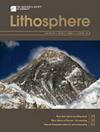四川大路桥碳酸盐岩杂岩成因中的地幔交代作用与稀土富集——来自两种方解石类型元素地球化学和原位Sr同位素的启示
IF 1.7
4区 地球科学
Q3 GEOCHEMISTRY & GEOPHYSICS
引用次数: 0
摘要
在所有岩浆岩中,碳酸盐岩具有最高的稀土元素(REE)含量,但碳酸盐岩富集稀土元素的机制仍然是一个谜。碳酸盐岩方解石为解决这一问题提供了重要的矿物学和地球化学见解。本文研究了四川大路桥碳酸盐岩杂岩中两种方解石的主微量元素地球化学数据和原位Sr同位素数据。我们的主要目标是阐明肥沃碳酸盐的起源。这些方解石被认为起源于不同的碳酸盐演化阶段。ⅰ型方解石在碳酸盐岩岩浆作用早期结晶,具有自面体粒状结构,表面均质。II型方解石形成于热液叠印流体环境中,与共生共生中的bastnäsite密切相关。两种方解石类型均表现出高放射性成因(87Sr/86Sr)i比值,ⅰ型方解石为0.7059 ~ 0.7060,ⅱ型方解石为0.7059 ~ 0.7068。大陆沟方解石的高锶(I型方解石为3646 ~ 7315µg/g, II型方解石为6566 ~ 13427µg/g)和均匀的Pb同位素组成(206Pb/204Pb比值为18.23 ~ 18.27)驳斥了地壳同化成因假说。相反,放射性成因的Sr同位素组成表明,俯冲的海相沉积物污染了产生碳酸岩浆的岩石圈地幔。矿物学证据表明,大路桥碳酸盐岩中存在丰富的硅酸盐矿物,结合已发表的C-O同位素数据汇编表明,这些碳酸盐岩可能是由交代岩石圈地幔的低程度部分熔融(熔融比例<1%)造成的。最后,提出了大鹿漕碳酸盐岩杂岩稀土富集的综合模式,并探讨了构造作用在肥沃碳酸盐岩成因中的意义。本文章由计算机程序翻译,如有差异,请以英文原文为准。
Mantle Metasomatism and REE Enrichment in the Genetic Source of the Dalucao Carbonatite Complex (Sichuan, China): Insights from Elemental Geochemistry and In-Situ Sr Isotopes of Two Calcite Types
Abstract Carbonatites possess the highest rare earth element (REE) concentrations among all magmatic rocks, yet the mechanisms governing the enrichment of REEs in carbonatites remain enigmatic. Carbonatite-hosted calcites provide crucial mineralogical and geochemical insights into addressing this matter. In this study, we present a dataset comprising major and trace elemental geochemistry, as well as in-situ Sr isotopic data, for two types of calcites from the Dalucao carbonatite complex in Sichuan Province, China. Our primary objective is to shed light on the origin of fertile carbonatites. These calcites are believed to have originated at different stages of carbonatitic evolution. Type I calcites, characterized by a euhedral granular texture and a homogeneous surface, crystallized at the early stage of carbonatite magmatism. In contrast, type II calcites, closely associated with bastnäsite in a paragenesis, formed within a fluid setting of hydrothermal overprinting. Both calcite types exhibit highly radiogenic (87Sr/86Sr)i ratios, ranging from 0.7059 to 0.7060 for type I calcites and 0.7059 to 0.7068 for type II calcites. The high Sr concentrations (3646–7315 µg/g for type I calcites and 6566–13,427 µg/g for type II calcites) and uniform Pb isotopic compositions (206Pb/204Pb ratios of 18.23–18.27) in the Dalucao calcites refute the hypothesis of crustal assimilation as their genetic source. Instead, the radiogenic Sr isotopic compositions suggest that subducted marine sediments have contaminated the lithospheric mantle that generated the carbonatitic magma. Mineralogical evidence indicating the presence of abundant silicate minerals in the Dalucao carbonatites, combined with a compilation of published C-O isotopic data, suggests that these carbonatites may have resulted from low-degree partial melting (melting proportion <1%) of a metasomatized lithospheric mantle. Finally, we propose a comprehensive model for REE enrichment in the Dalucao carbonatite complex and explore the significance of tectonism in the genesis of fertile carbonatites.
求助全文
通过发布文献求助,成功后即可免费获取论文全文。
去求助
来源期刊

Lithosphere
GEOCHEMISTRY & GEOPHYSICS-GEOLOGY
CiteScore
3.80
自引率
16.70%
发文量
284
审稿时长
>12 weeks
期刊介绍:
The open access journal will have an expanded scope covering research in all areas of earth, planetary, and environmental sciences, providing a unique publishing choice for authors in the geoscience community.
 求助内容:
求助内容: 应助结果提醒方式:
应助结果提醒方式:


